 |
| The captain put me in charge of getting us from point A to point B. I was responsible for upping anchor, route planning, navigating and dropping the hook at our destination. |
My cruising life started and nearly ended in 2007. It just wasn’t what I thought or hoped it would be.
It was clear: never darken the boarding ladder again, or find out for myself what I wanted from cruising. My own approach to living in this watery world for months at a time.
I wondered what other cruising women were thinking about and doing on their boats. So I started to ask them. One of the areas we talked about was educating ourselves.
Common amongst the women I spoke with was a learning style based on doing.
Explanations, instructions, words, only go so far. Perhaps it’s my own conclusion but the women seemed similar to me in this regard.
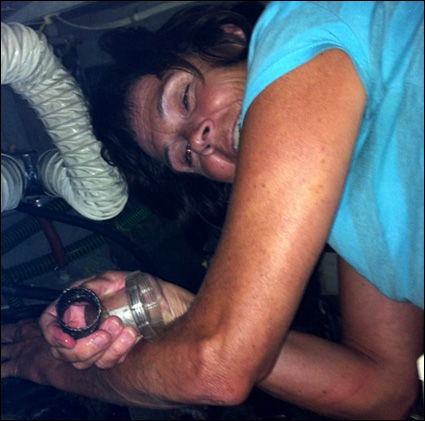 |
| Crawling into the engine room to clean the shower pump filter. A small but vital job. |
I sensed, too, that explanations and instructions could be an obstacle to learning – especially when offered by a spouse. Not to be negative about the spouse’s efforts and intent. It can simply be a mismatch of teaching and learning styles – a situation I’m familiar with.
It is absolutely necessary to immerse myself in whatever subject area of sailing that I wish to learn. I cannot standby and hope to learn. Some observation is important but I have realized that unless I force myself to read weather books so I can be part of weather discussions; take time to pour over charts; pay attention to local knowledge when it’s being shared; I cannot really be part of route planning.
An impediment to learning shared by more woman than just me is a spouse who is more knowledgeable.
 |
| The Captain agrees to dock lines and duct tape to restrain himself from taking over. |
It’s sometimes easier to abdicate and let the more competent person do it. And sometimes the more competent person has a hard time letting go and giving the student space to learn. It can be a difficult balance to find. When something needs to be done now and done right, it’s not a time to chance a mistake.
However, most moments on the boat are not like that and there is room for learning from one’s mistakes.
The challenge is for the student to be persistent in their own learning. Watch, read, talk to others, and try. Don’t stop trying. Insist with yourself and others that you will keep on trying. Above all, resist berating yourself for not knowing or making a mistake. Lock your successes firmly in your mind and touch on them often.
There are a few key knowledge areas that came up in my discussions with women.
Sailing
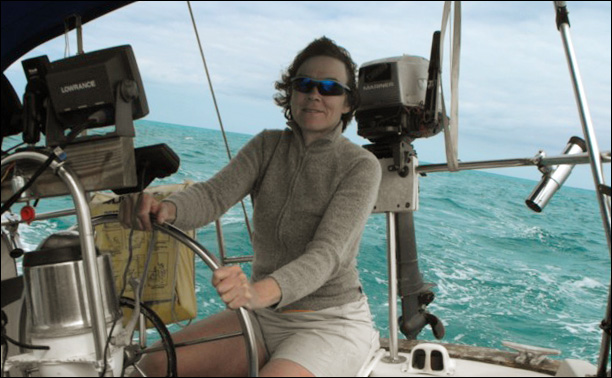
Two women I talked to really stand out for me.
The first one, a single hander, learned to sail on the 25 foot sailboat her and her husband bought when their kids were young. They would head out to their boat on weekends. Saturday morning was her time to take the boat out alone. She’d try this, that and everything in between as she figured out how to set the sails, manage the lines and navigate. Later, she’d talk to her husband about her morning solo experience and sort out any questions she had.
Years later the marriage ended. The husband didn’t want the sailboat but she did. She continued to take the kids out on sailing weekends. Her sailing and boat handling knowledge continued to grow – as it’s bound to when you spend time with the boat on the water.
Today, one of her grown sons owns a boatyard. And she single hands her 42 ft sloop throughout the Bahamas and Caribbean, taking crew on board for passages as needed.
I’m wowed. But I totally get it. I could see myself taking a small sail boat out alone on the lake we live near at our land based home. I could mess around and if I couldn’t get myself back to shore I could radio for help. (Always good to have a fall back position!) I could practice reading the wind, setting the sails, tacking and jibing, coming along side bouys, to my heart’s content. No one to critique or offer up a flow of words (well meaning advice) that I just can’t process when I’m in my “experiential learning” mode. I could bask in the glory of making and solving my own mistakes. It’s what I do best. So why not do it on a sailboat?
I have in fact met another female single hander moored at St. Augustine, Florida who subscribes to the trial and error learning method herself. And she knows other women single handers that do, too! I’m not alone! I want to sail away with these women! I ask her if she was afraid of running into stuff. She tells me it’s a foregone conclusion that you will hit things. And she has run into things. So have her single handing friends. No major catastrophes ensued. It’s ok. (If you think about, many male captains have at least one story of running into a dock, shallow spot, wall, boat, etc. and have lived to laugh about it.)
The second woman that stands out in my conversations about how women learn to sail their boats, took a sailing course. It was a very good course, she says, and co-ed. When it came to the hands on sailing, an interesting – but not totally surprising – thing happened. The men wanted to step up and do all the “heavy” work. She had to literally elbow them aside saying “I came here to learn”. It was the right thing – the only thing – for her to do, in my books. At the same time it takes courage and decisiveness. Hmmm, yes it does.
Many other women have talked to me about the value of the women only sailing courses they’ve taken. I intend to do that one day but, as yet, have not had the time and money. And I’m getting more interested in the idea of a small sailboat on our lake back “home”.
Charts, Route Planning and Navigating
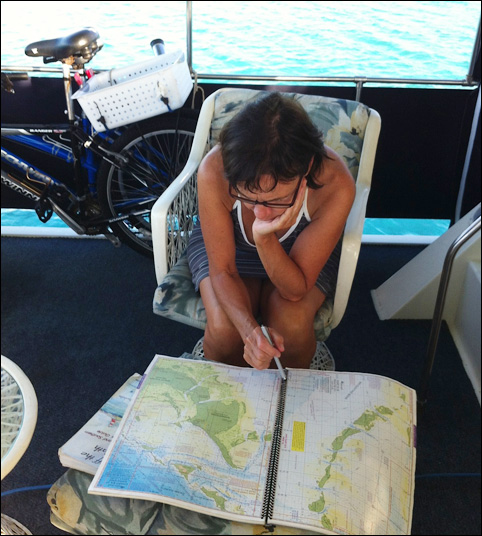 |
| Consulting the charts and cruising guide before setting out on the next leg of our trip. |
At first, sea sickness kept me from studying the charts. Charts are key, though! (And in this digital age, many would argue that so is the chart plotter.) Charts are to sailing as road maps are to driving and topographical maps are to wilderness travel.
So I started looking at the charts when we were at anchor or on a very calm passage. I discovered that my background in using topographical maps for hiking and canoe trips, compasses, and latitudes and longitudes gave me a good start with the charts.
Charts can’t be read in isolation from weather (primarily wind direction and speed), low and high tides, and sunrise and sunset. All these factors are woven into an intricate blend of information for sailors’ decisions. And provide the fodder for a favourite cruiser discussion – where and when to go next.
I found, too, that I use the charts slightly differently than my spouse. For example, I rely more on latitude and longitude readings, and topographical features. I wouldn’t have discovered this if I had tried to use charts exactly the way he does.
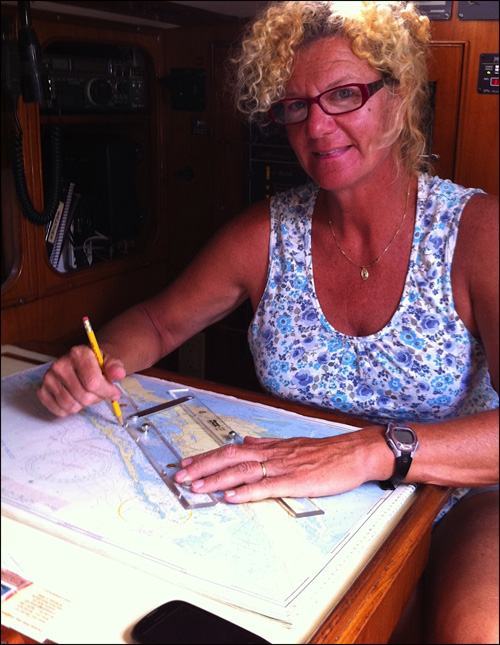 |
| My friend Jo on s/v Serenade works out her routes with paper, pencil and straight edge – a skill she acquired in the classroom and with practice. |
A woman sailor told me that she preferred to rely on one source of information for navigating. Multiple sources just confused things for her.
She relied on a handheld Garmin and sight, along with paper charts. She had navigated from Florida south to the Jumentos in the Bahamas and did not appear lost, so her system worked. (I think of the costly chart plotters I’ve seen at the West Marine store. They look like flat screen TVs to me. I will allow that perhaps they are worth every penny to some, but at present they seem like overkill to me.)
I’m glad to hear about the good service her handheld Garmin has done. We have one on board for back up to the modestly sized chart plotter mounted at the helm station.
Electrical Systems
 |
| The charger/inverter controller is where it’s at if you want to know how your system is charging. Ours is installed by the electrical panels. There is no shortage of dials and switches. |
One woman I talked to is reading a manual on marine electrical systems to educate herself on how things work! Impressed, my eyebrows raised, all I can say is ‘wow”!
For the first few years, my knowledge was limited to understanding that batteries are recharged when the engine or generator is running and that we need a couple hours a day of either (or a mix) to keep electricity flowing. And I understood – as I do now – that electricity conservation is a must. Perhaps that’s the first thing to understand about electricity.
Another woman I spoke to dealt with electricity knowledge by not needing it. She owns a boat with her grandfather. Together, they set the goal of not turning on the engine. She is the first woman I’ve met that is nearly exclusively wind powered. She has a solar panel to power the vhf radio for communication, and a single side band receiver and am/fm radio from which they try to get weather information. Simplicity. Of course, the trade-offs are less weather information opportunities, and no cold beer, butter, and hot showers. Some days I bet the trade-offs are worth it, and some days not.
I’ve started reading books about electricity, batteries, inverters and chargers. Last week I went to a boaters’ seminar on electrical systems. (Before the seminar started a man sitting beside us said to me I was probably there to learn how to use the blow dryer. He had the good grace to realize he probably shouldn’t have said that.)
The next day I took notes as my husband set up the generator to charge the batteries. My next challenge is to do the set up myself. (All boats are set up differently – ours is moderately complex.) I can now have a basic conversation with my spouse about our own system aboard. Last year, I crawled into the far reaches of engine room to check the water level in the batteries. Not rocket science but, hey, it’s a start. (At the same time I made a foray into plumbing maintenance. I removed, cleaned and replace the filter basket in the line that drains the shower. )
At this point in my conversations with women, I know I’m in good company when I say I need to learn about this sailing life by doing, more so than watching or being told.
It can be a struggle to not sit back passively and let others do the things that right now seem too challenging. For me, though, learning is the only way I’m going to really get into this cruising life.
About Karen Bergman
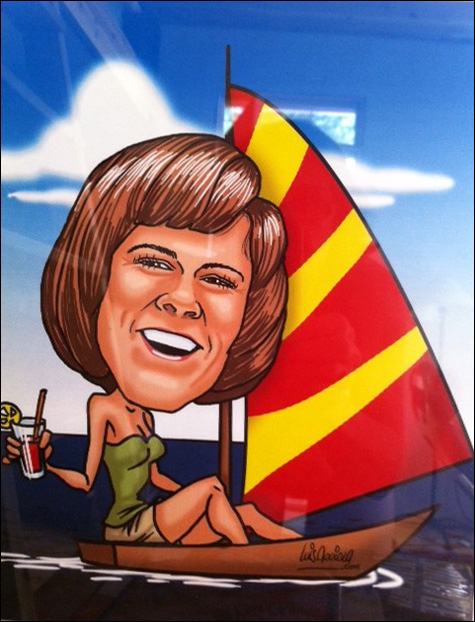 |
| A caricature of me my former colleagues gave to me when I retired last year. Sailing /cruising seems so exotic to those who haven’t done it. |
I was born and raised in southern Alberta, Canada. For over 22 years I lived in Canada’s Arctic where my children were born and raised. My first adventure on the ocean was in an open boat to fish and hunt seals. In early spring we travelled on the frozen ice by snowmobile and komatik (a sled with runners). (No, we didn’t live in igloos! And, yes, we had electricity and running water.)
When I was young, I had romantic dreams about sailing around the world. I didn’t really think about how that would work given I get motion sick on a swing. My first adventure on a sail boat in 2007 saw us traveling around the Florida panhandle in a 32 foot Pearson, Island Breezes. I remember the heat, nausea, lightning storms and a water spout bearing down on us when our motor was disabled. Our max speed was 1 knot. I was terrified.
And unimpressed by the whole thing. I thought there had to be more to this cruising life. Next year we cruised in the Bahamas. That was more like it and I found enough in it to stick with cruising. We’ve been back to the Bahamas several times and also cruised (as crew on another boat) in south and central America. Currently, our cruising platform is m/v Popeye, a 42 foot Tolleycraft.
I retired from a wonderful public service career in 2011. I live now in southern British Columbia, Canada with my partner Dwight on 5 acres of solid land with mountains, lakes and rivers nearby. Between us, we own 9 boats, including the canoe and kayaks. I have three children and two granddaughters.
I’ve just started blogging again: Karen Blogs Again.
- Debbie Leisure learns to sail her boat single-handed: Learning to handle the boat alone after a husband’s death.
- All posts in “How we learn” : Women tell us how they have learned the skills they need to sail and cruise.
- “Learning to sail”: Women & Cruising resources
- What do women like most about sailing their boats? by Karen Bergman


This was a wonderful read this morning, while sipping my first coffee! Congratulations, Karen, on a great philosophy of learning. We all need to apply this very thing to everything we explore in life…and keep exploring. This is what gives us joy. Your writing was both fun and informative. Thank you.
Thanks,Kath! You’re an inspiring example of how to explore your way through life.
Great article Karen. You are so right. Women and men have different styles of learning. I took lots of courses. But I realized I would never learn — truly learn — until I took a boat out on my own. Lots of years later, I am still learning but I can single hand a 40 foot sloop and have crossed oceans several times over.
But what I really want to know is how I can tweet and star and like the photo of the Captain restrained? Priceless!
Daria, I’ve just got onto tweeting so will look into how that can be done with the captain’s photo. (he would love to be tweeted, I’m sure!)
Most importantly, thanks for your comments. It’s a good feeling to have confirmation of my own views based on my limited experience.
I’d love to hear more about your sailing life. Do you have a blog? Book?